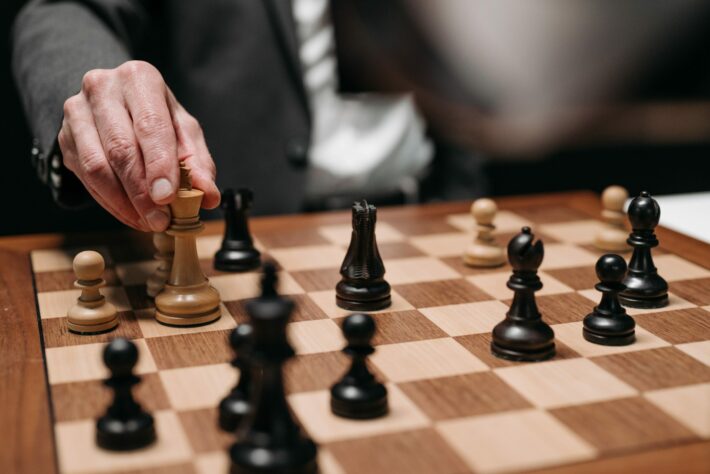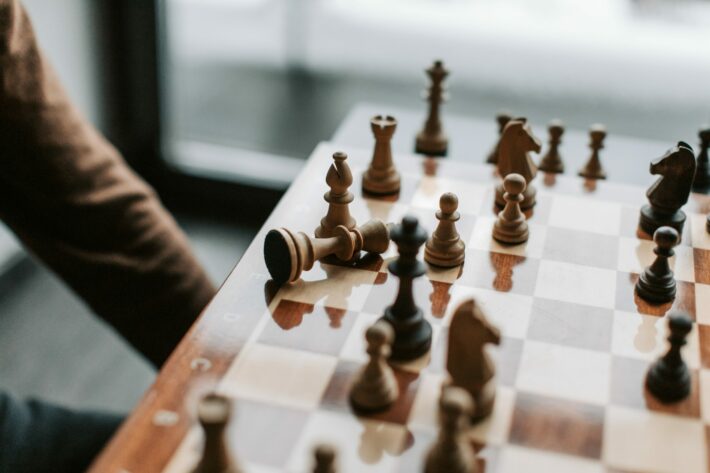The endgame phase of chess is where battles are won and lost. It requires precise calculation, strategic planning, and a deep understanding of key principles. In this guide, we will explore a range of powerful strategies and techniques to elevate your endgame play to new heights.
From pawn structures to piece coordination, and tactical opportunities to converting advantages, this comprehensive guide will equip you with the tools you need to dominate the chess endgame.
What are the essential principles for excelling in the chess endgame?
To excel in the chess endgame, it is crucial to grasp and apply a few essential principles. First, prioritize king activity by centralizing it, enabling it to support your pieces and participate in key operations. Secondly, pawn play becomes critical as creating passed pawns and promoting them to queens can decisively tip the balance in your favor.
Thirdly, piece activity remains crucial, and activating your rooks and minor pieces optimally allows for coordinated attacks and defensive maneuvers. Lastly, accurate calculation, prophylaxis, and an understanding of endgame-specific tactical motifs contribute to your success in this phase of the game.
How can I improve my decision-making skills during the endgame?

Improving decision-making skills in the chess endgame requires a combination of strategic awareness and accurate evaluation. Firstly, understanding the imbalances and specific characteristics of the position is crucial to make informed choices.
Analyzing pawn structures, piece activity, king safety, and potential tactical opportunities help guide your decision-making process. Secondly, considering long-term plans and objectives rather than solely focusing on immediate gains can lead to more favorable outcomes. Finally, analyzing master games, practicing endgame puzzles, and seeking feedback from stronger players can further enhance your decision-making abilities in the endgame.
What are the key strategies for creating winning pawn structures in the endgame?
Creating winning pawn structures in the endgame is vital for success. One strategy is to establish a passed pawn, which is a pawn with no opposing pawns on its file or neighboring files. Advancing this pawn with support from your king and pieces can put significant pressure on your opponent.
Another strategy involves creating pawn majorities on one side of the board, allowing for pawn breakthroughs and eventual promotion. Additionally, pawn islands should be minimized to maintain pawn unity and flexibility. By employing these strategies, you increase your chances of achieving a favorable endgame pawn structure.
How do I assess the importance of piece activity in the endgame?
Assessing piece activity in the endgame is crucial for determining the strength and potential of your pieces. Active pieces exert more influence, control key squares, and are better positioned to launch attacks or defend. Rooks should be centralized and connected, controlling open files and supporting pawn advances.
Knights and bishops should be placed on optimal squares, avoiding the restriction of their pawns. Additionally, piece coordination and harmonious interplay contribute to the overall piece activity. Evaluating the activity of your pieces and striving to improve their positioning will enhance your endgame play.
What are the common mistakes to avoid in the chess endgame?
In the chess endgame, it is important to be aware of common mistakes to avoid costly blunders. One common mistake is neglecting king safety. Failing to safeguard your king can expose it to potential checks, forks, or mating threats. Another mistake is disregarding pawn play.
Overlooking the importance of pawn structures, pawn breaks, and pawn promotion can lead to missed opportunities or weakened positions. Additionally, neglecting piece coordination, underestimating endgame tactics, and miscalculating move sequences are errors to be mindful of. By learning from these common mistakes, you can improve your endgame skills and avoid unnecessary pitfalls.
How can I exploit my opponent’s weaknesses in the endgame?
Exploiting your opponent’s weaknesses in the endgame requires strategic and tactical awareness. Identify your opponent’s vulnerable pawns or weak squares and direct your efforts toward them. Targeting isolated pawns, backward pawns, or doubled pawns can apply pressure and restrict your opponent’s options.
Provoking weaknesses by creating threats or forcing unfavorable pawn structure changes can also be effective. Additionally, recognizing tactical opportunities, such as exploiting pinned pieces or overloaded defenders, allows you to gain an advantage. By staying alert to your opponent’s weaknesses and capitalizing on them, you can increase your chances of success in the endgame.
What are the best ways to improve my calculation abilities in the endgame?
Improving calculation abilities in the endgame is crucial for accurate decision-making. One effective way is to practice solving endgame puzzles and positions, which train your calculation skills and help you analyze various continuations.
Another method is to review and analyze master games, observing how strong players calculate and anticipate moves in endgame situations. Developing visualization skills by mentally exploring different move sequences can also enhance your calculation abilities. Regularly practicing calculation exercises and seeking feedback on your analysis will gradually improve your precision and efficiency in calculating moves during the endgame.
How do I handle complex pawn endgames effectively?
Handling complex pawn endgames effectively requires a combination of strategic planning and accurate calculation. Assessing the pawn structure and potential pawn breaks is crucial for formulating a winning plan. Centralizing the king, activating the rooks, and creating passed pawns are common strategies in pawn endgames.
Evaluating king safety and understanding zugzwang positions becomes essential for exploiting tactical opportunities. Additionally, accurately calculating pawn race situations, accurately evaluating pawn captures, and understanding corresponding square systems contribute to effective decision-making. By studying and practicing complex pawn endgames, you can develop the skills needed to navigate and succeed in these challenging scenarios.
What are the recommended methods for improving my endgame technique?

Improving the endgame technique requires a comprehensive approach. Firstly, studying endgame theory and familiarizing yourself with fundamental concepts, such as pawn structures, piece coordination, and king activity, provides a solid foundation. Analyzing master games, particularly those featuring prominent endgame players, helps to grasp strategic and tactical ideas.
Additionally, solving endgame puzzles and practicing with endgame-specific exercises enhances pattern recognition and decision-making skills. Engaging in regular play and analysis of endgame positions also aids in honing technique. By combining theoretical knowledge, practical application, and deliberate practice, you can steadily improve your endgame skills and technique.
How can I utilize my king effectively in the endgame?
Utilizing the king effectively in the endgame is crucial for both defensive and offensive purposes. One strategy is to centralize the king, bringing it closer to the action to support your pieces and participate in attacks or defenses.
Another aspect is utilizing the king as a powerful attacking piece during pawn endgames, where it can participate in pawn breakthroughs or support passed pawns. Furthermore, ensuring the safety of the king by avoiding unnecessary risks and potential mating threats is vital. By utilizing your king effectively, you enhance your endgame prospects and increase your chances of success.
What are the most effective ways to create passed pawns in the endgame?
Creating passed pawns in the endgame can significantly enhance your winning chances. One effective way is through pawn breaks, advancing a pawn to create a passed pawn that your opponent must deal with.
Another approach involves pawn promotion, transforming a pawn into a queen or other powerful piece. Centralizing the king, coordinating your pieces, and employing tactical ideas such as breakthroughs and pawn sacrifices can also help create passed pawns. By recognizing opportunities to create and advance passed pawns, you can exert pressure on your opponent and tilt the endgame in your favor.
How do I recognize and exploit tactical opportunities in the endgame?
Recognizing and exploiting tactical opportunities in the endgame requires a sharp eye and tactical awareness. Look for tactical motifs such as pins, forks, skewers, and discovered attacks. Identifying overloaded pieces and weak back ranks can lead to tactical possibilities.
Calculating accurately and considering all forcing moves is crucial. Evaluating tactical sacrifices and assessing potential counterplay from your opponent is also important. By staying alert to tactical opportunities and employing sound calculation, you can seize tactical advantages and turn the tide in the endgame.
What are the crucial principles for maneuvering my pieces in the endgame?
Maneuvering pieces effectively in the endgame can be a game-changer. Centralization is key, aiming to place your pieces on active and influential squares. Rooks belong on open files and behind passed pawns. Minor pieces should be positioned to control important squares and coordinate with other pieces.
Create outposts for knights, ideally supported by pawns, to maximize their effectiveness. Coordination between your pieces is essential, enabling them to work harmoniously towards your strategic goals. By adhering to these principles, you can optimize your piece play and gain a significant advantage in the endgame.
Below is a table that shows the Principles for Effective Piece Maneuvering in the Chess Endgame
| Principle | Description | Example |
|---|---|---|
| Centralization | Moving your pieces towards the center of the board to maximize their influence and activity. | Repositioning your rook to control key central squares and support pawn advances. |
| Coordination | Ensuring harmony and synergy between your pieces to create powerful attacking or defensive setups. | Coordinating your bishop and knight to create threats against your opponent’s king. |
| Outposts | Occupying strategically advantageous squares with your pieces, especially knights, where they are well-supported and difficult for your opponent to dislodge. | Placing your knight on an outpost in the center of the board, controlling key squares, and restricting your opponent’s mobility. |
| Maneuvering for Exchanges | Positioning your pieces to facilitate favorable exchanges, such as trading a less active piece for a more active one, or eliminating your opponent’s strong pieces. | Reorganizing your rooks to target your opponent’s weak pawns and forcing an exchange that leaves you with a material advantage. |
| Restricting Opponent’s Pieces | Limiting the mobility and options of your opponent’s pieces by creating positional barriers or threatening their activity. | Blocking your opponent’s bishop with your pawns, restricting its range and reducing its effectiveness. |
What are the most effective ways to convert an advantage into a win in the endgame?
Converting an advantage into a win in the endgame requires precise play and strategic decision-making. Firstly, simplify the position by exchanging pieces while maintaining your advantage. Create passed pawns and promote them, leveraging them as a decisive force. Focus on king safety, avoiding unnecessary risks that could compromise your advantage.
Maintain piece activity and coordination to apply pressure on your opponent. Additionally, accurate calculation and tactical awareness help identify winning continuations and avoid pitfalls. By adhering to these principles, you can effectively convert your advantage into a victorious endgame outcome.
How do I approach endgames with bishops of opposite colors?
Endgames with bishops of opposite colors demand careful maneuvering and strategic understanding. In such scenarios, the player with the initiative should seek active piece play and exploit potential weaknesses in the opponent’s pawn structure.
Create threats that force the opponent to weaken their pawn shield. Coordination between your pieces becomes vital, utilizing the bishop’s long-range capabilities to control key squares. However, be cautious about creating weaknesses in your position. Utilize tactical opportunities to gain an advantage and convert it into a winning position. By approaching these endgames strategically, you can maximize your chances of success.
What are the typical plans and ideas in rook endgames?
In rook endgames, typical plans and ideas revolve around activating the rook and utilizing its power. Centralize your rook on open files to control critical squares and target weak pawns. Coordinate your rook with your king and other pieces to create threats and potential mating nets.
Aim for rook invasions into the opponent’s camp to disrupt their coordination and apply pressure. Additionally, the creation of passed pawns and advancing them with the support of the rook can be a winning strategy. By executing these plans and ideas, you can gain an upper hand in rook endgames.
How can I improve my technique in pawnless endgames?

Improving technique in pawnless endgames requires a solid understanding of key principles. Rely on the activity of your king, aiming to centralize and support your pieces. Utilize piece coordination and harmony to create threats and restrict your opponent’s options. King safety becomes paramount, as checks and threats can quickly turn the tables.
Calculation skills are crucial to navigating complex variations and accurately evaluating resulting positions. By studying theoretical endgames, practicing with puzzles, and analyzing master games, you can enhance your technique in pawnless endgames and increase your chances of success.
Given this points
Mastering the art of playing a strong endgame in chess is essential for aspiring chess players looking to improve their skills and secure victories. The endgame is the phase where strategic moves and precise calculations determine the outcome. To excel, focus on key aspects such as king activation, pawn promotion, and piece coordination.
Practice essential endgame tactics like Zugzwang, opposition, and triangulation to outmaneuver opponents. Study classic endgame positions and grandmaster games to gain insights into successful strategies. Regular practice, analysis of past games, and learning from mistakes contribute to honing endgame skills. Embrace patience, precision, and perseverance to elevate your endgame play and achieve chess mastery.




